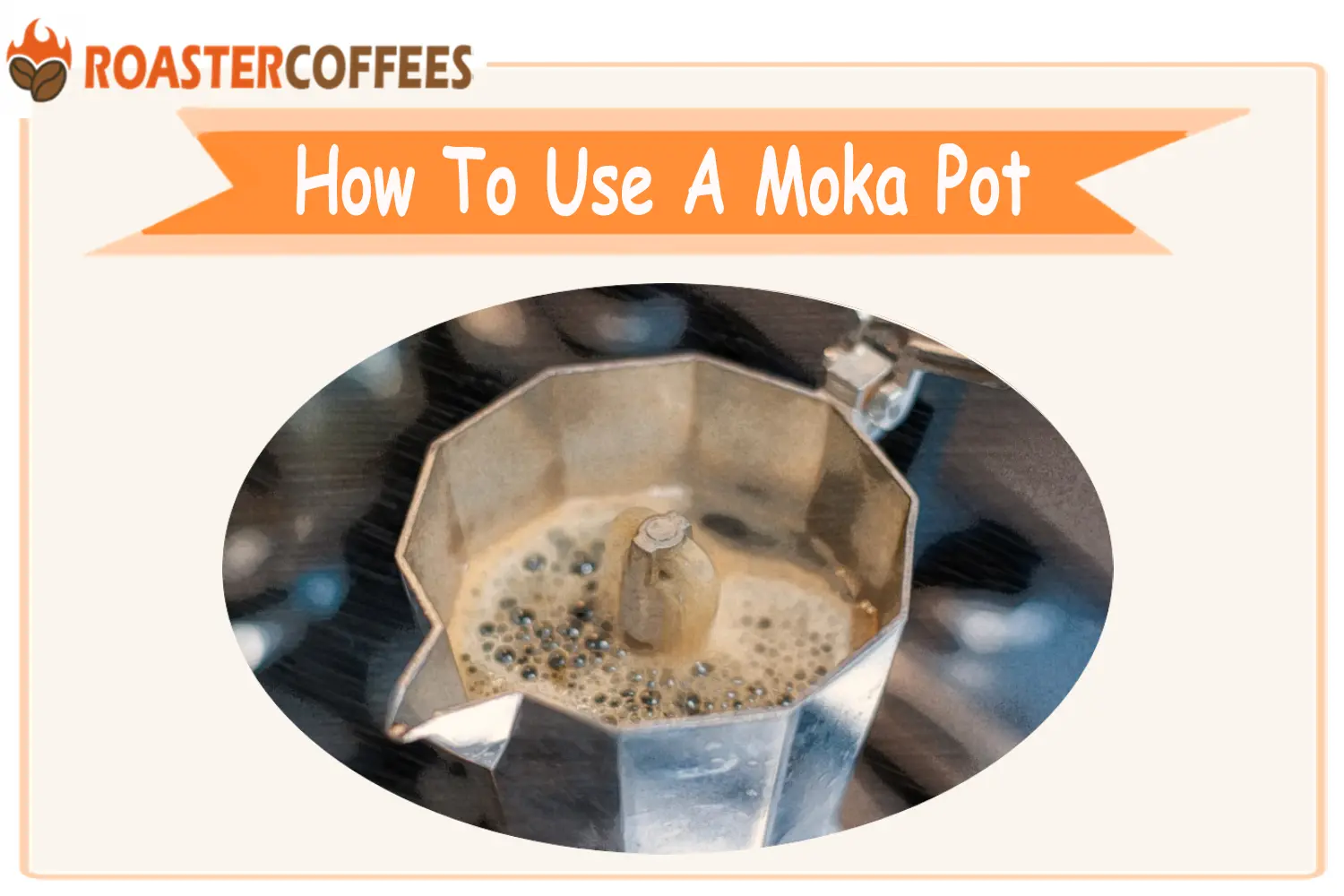
As an espresso fanatic, have you always been craving a delicious espresso at home but worried that espresso machines are expensive? If you search for an affordable and traditional way to make espresso-style coffee, don’t miss the Moka Pot.
In this article, we will show you how to use Moka pot step by step, what Moka pot is and how it works.
Moka Pots produce espresso-style coffee that is not as strong as espresso but not as light as a drip coffee. They are a perfect blend.
Although it is not a real espresso, the coffee brewed by Moka Pot is 2-3 times stronger than regular drip coffee, which can still satisfy the cravings of an espresso fanatic.
Moka pots are sometimes called stovetop espresso machines.
It was first invented in 1933 by the Italian engineer Alfonso Bialetti, and it soon became one of the main parts of Italian culture.
Making espresso in Moka Pot is easy and effective. Its function is straightforward and easy to operate, and it is also a classic and exquisite brewing style. Not to mention just fun.
Moka pot achieves magical effects through two elements: pressure and heat. The four main parts to accomplish this are the base, the top chamber, the internal funnel, and the filter.
Fill the Moka pot’s bottom chamber with water and place the coffee grounds in the filter above the water. Once heated, steam is generated, forcing the water through the filter, creating a strong coffee shot.
Stovetop Espresso Coffee Is Real Espresso?
Although the Moka pot is called a stovetop espresso machine, it does not make real espresso.
Moka pots generally produce a 1-2 bar pressure( 1 standard atmospheric pressure bar represents 14.7 pounds per square inch), which cannot reach the 9 bar pressure required to produce espresso.
Its pressure is not enough to form the perfect crema texture, which is the main difference from the real espresso.
However, in terms of flavor, it is very close. You can still use it to make espresso-like coffee.
What You Need
Are you ready? We are about to start making coffee in Moka Pot. But before you start, the follows are what you need:
- A Moka Pot (The Stovetop Espresso Maker)
- Coffee beans
- A coffee grinder
- Filtered water
- A stovetop
How To Use Moka Pot: Step By Step
1. Prepare Your Moka Pot
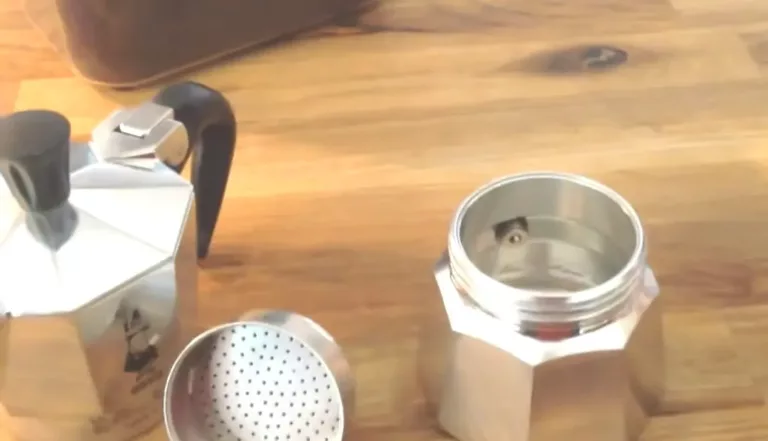
Separate your Moka pot into three parts:
- Lower chamber for water
- The filter for coffee grounds
- The upper chamber for the final coffee
2. Grind Coffee Beans
Grind the coffee beans until finely ground, finer than you use for pour-over, but not as fine as for espresso. Do not use too fine grounds. Otherwise, it may leak and cause problems.
3. Add Water
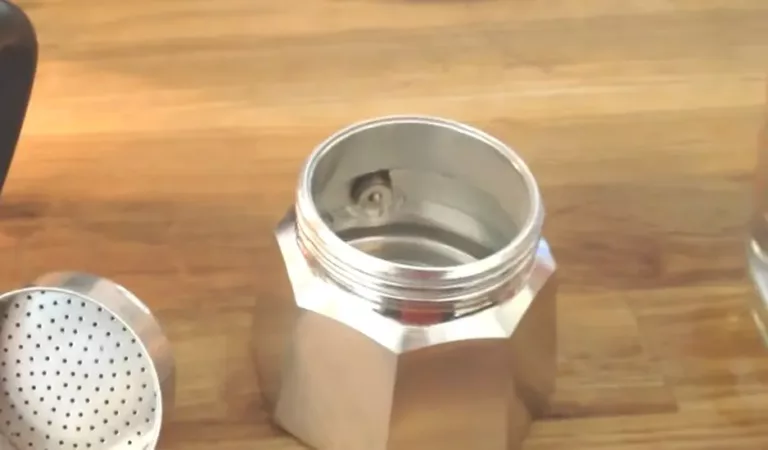
Fill the lower chamber with cold filtered water. Remember not to exceed the safety valve.
4. Add Coffee Grounds
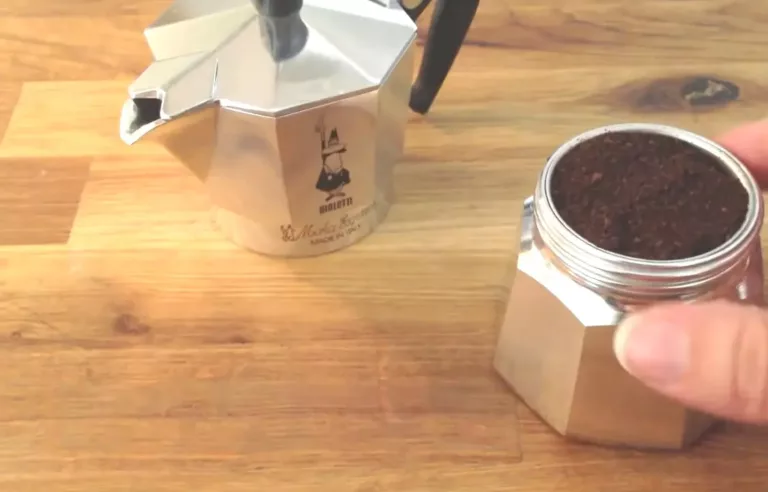
Fill the filter basket with coffee grounds to make sure it is full. Use your fingers to level the ground, do not tamp. Then remove any grounds on the edge of the filter basket.
5. Reassemble Your Moka Pot
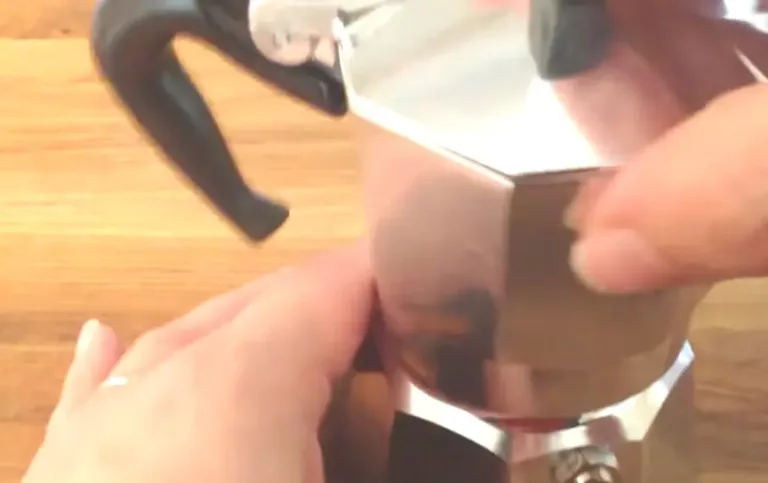
You are almost done. All that remains is to restore your Moka pot. First, put the filter back into the lower chamber, then screw the top chamber to the base. When tightening, remember to hold the pot instead of the handle because the pressure when tightening the pot may break the handle. One more point, don’t screw the upper chamber too tight. Just make sure it’s tightened firmly.
6. Heat Your Moka Pot
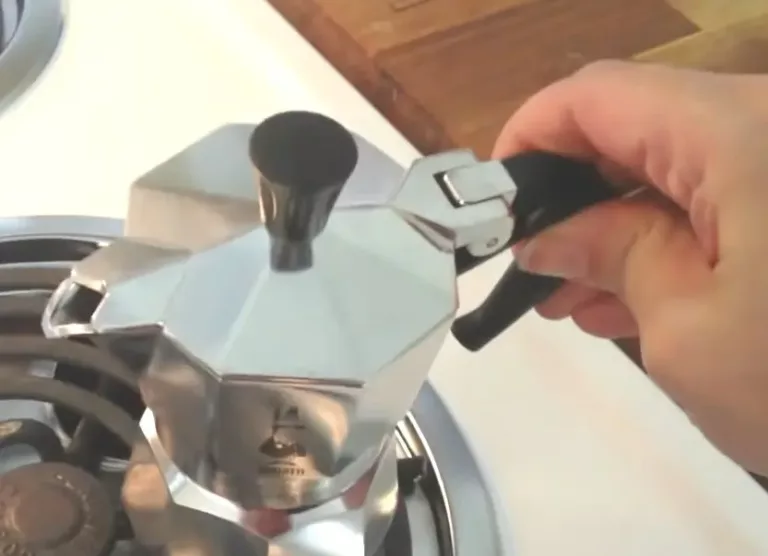
Put your Moka pot on the stove, turn on the stove and wait for the water to boil.
To fully extract the flavor of espresso, you need to heat it slowly. If the temperature is too high, the coffee will start to “spatter” when poured and may taste burnt. If it happens, please re-brew and heat the Moka pot to a slightly lower temperature.
Remember not to leave your pot alone during the heating process because you need to be there when it starts to boil, also for safety. If using a gas stove, be careful that the flame will not melt the plastic handle.
7. Pour Your Coffee

When the water in the bottom chamber is close to boiling, the pressure will steadily push the coffee into the upper room. When you hear the gurgling sound, you know it is done. Immediately remove the Moka pot from the stove. Let the coffee flow entirely into the upper chamber, and then pour it.
Remember, don’t leave the coffee on the stove for more than a few seconds after the gurgling starts because one of the main problems with making espresso in this way is the burnt taste causing by overheating during the brewing process.
8. Clean The Moka Pot
Clean the Moka pot for the next cup. Once it is cool enough to handle the pot, unscrew the top and remove the rubber gasket and filter plate above the filter basket. Use soap-free warm water to thoroughly clean all parts. If you cannot remove any remaining coffee oil, please use a special coffee cleaner to remove the residue without producing a soapy taste. Then dry it thoroughly with a towel. Before reassembling, make sure all parts are arid.
How Does A Moka Pot Work
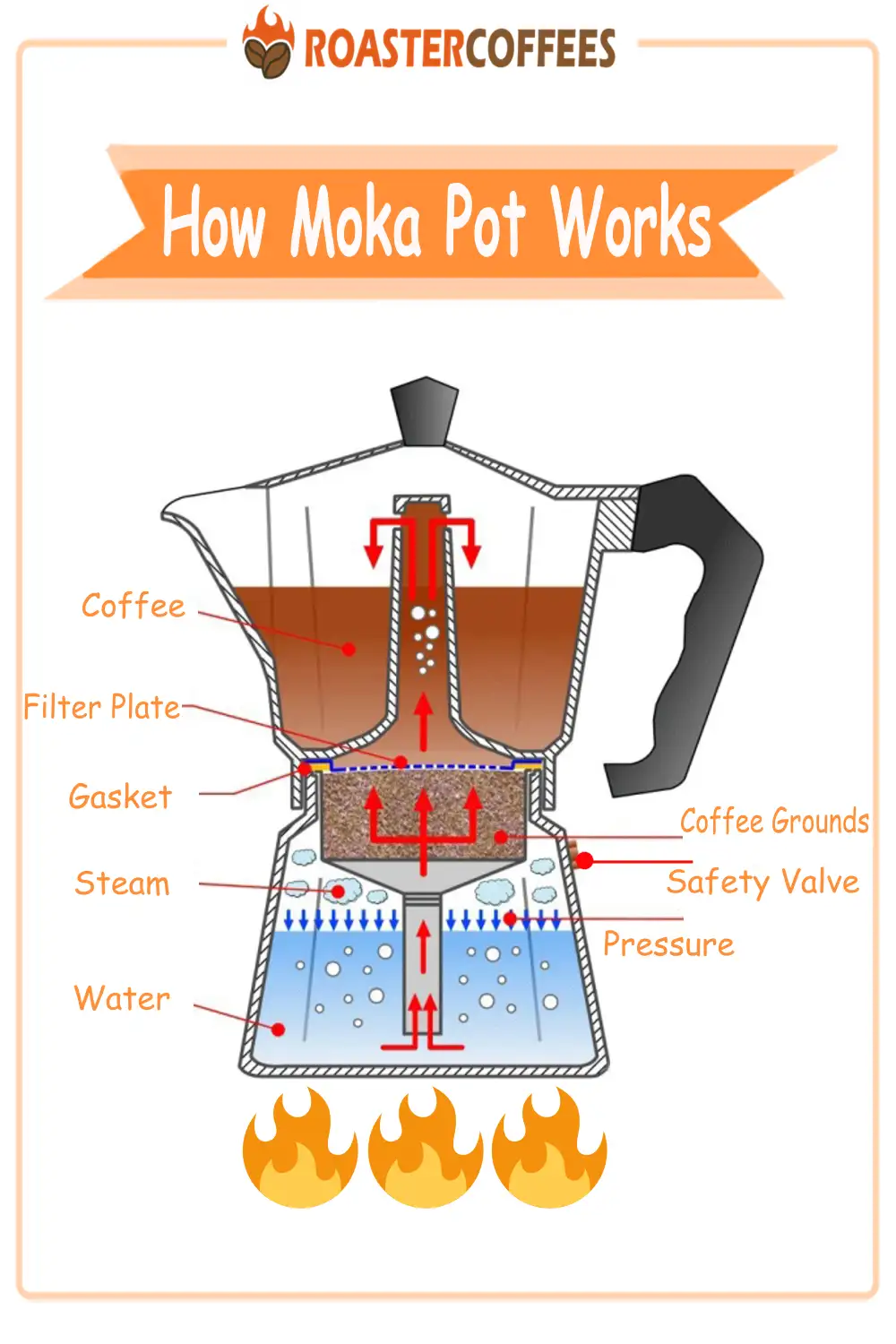
We know that the Moka pot has three chambers used for water, coffee grounds, and finished coffee.
When you place the pot on the stove, the water heats up and produces steam. It increases the pressure in the bottom chamber, pushing the water through the middle room where the coffee grounds are and into the upper chamber. Pour it, and your coffee is done.
Although the pressure formed in the pot cannot reach the pressure required to make espresso, the simplicity of its design, making it easy to operate, and its ability to produce high-quality coffee makes it popular in households.
Why Is Moka Pot?
For espresso lovers, the Moka pot produces rich and hearty coffee. Although it is not as strong as espresso, it is 2-3 times stronger than drip coffee.
Of course, its simple operation is also essential.
It is an economical way to make espresso-style coffee.
Troubleshooting
Steam Leaks From The Side
If steam or water leaks from the side, you must immediately remove the Moka pot from the stove. You should not take any risk of pressure wonky. When the pot has cooled, make sure it is tightly sealed and clean.
Your coffee grounds may be too fine, causing a clog. You can try slightly coarser settings next time.
Steam Leaks From The Valve
If the steam leaks from the safety valve, your pressure is a bit high, and you need to remove the pot from the fire. And check the following points:
- Make sure you don’t tamp the grounds
- Make sure you don’t fill too many coffee grounds
- If you check off the above two points, use lower firepower
Coffee Is Too Weak
If the cup is too weak, likely, the coffee grounds are unevenly distributed, causing water steam to form channels in the coffee grounds. Therefore, it is not extracted evenly from all coffee grounds but only from a small portion.
Next time, try tapping the filter basket to make the coffee check more evenly distributed, and level the ground with your fingers.
If this does not work, you may just need to use finer grounds to increase the extraction.
Coffee Is Too Stronger And Bitter
It means over-extraction. You can try the following ways to reduce extraction:
- Use slightly coarser grounds
- Reduce the firepower of the stove
- Stop brewing a few seconds ahead of time
Final Thoughts
If everything goes well and you have followed the step by step carefully, then you should look at the empty pot while drinking a cup of delicious Moka pot coffee. In the end, there is only one question left: how does it taste?
Moka Pot FAQs
Can You Use Regular Coffee In A Moka Pot?
Most people think that espresso needs espresso beans.
Espresso is just a brewing method that pushes hot water through coffee grounds at high speed and pressure (9-10 atmospheres, one standard atmosphere means 14.7 psi).
Although the Moka pot only produces 1-2 bars of pressure, it can still brew espresso-style coffee that is 2-3 times stronger than drip coffee.
So you can use regular coffee beans in the Moka pot if you think it is too strong. Espresso brewed with espresso beans is usually stronger. Remember, everything is just for your preferences.
Is Moka Coffee As Strong As Espresso?
Although the Moka pot is named stovetop espresso machine, it does not produce true espresso.
Moka pots can produce 1-2 bars pressure, which cannot reach the 9 bar needed to brew espresso.
Its pressure is not enough to form a perfect crema, which is the critical difference from true espresso.
Yes, the coffee brewed by the Moka pot is very strong and very close to espresso. You can use it to make espresso-style coffee, but it is not a real espresso.
How Long Does A Moka Pot Can Be Used?
If maintained and cleaned properly, the Moka pot can be used for decades.
On the other hand, a real espresso machine, it will last for several years. However, repairing or replacement of these machines can cost hundreds to thousands of dollars. For a Moka pot, if it is damaged, you can buy a new one for only a few dozen dollars.
It is an economical way to make espresso-style coffee.
How To Clean Your Moka Pot?
It is not difficult to clean the Moka pot thoroughly.
- After waiting for the pot to cool, unscrew the top chamber and take out the rubber pad and filter plate above the filter basket.
- Wash all parts thoroughly by hand with warm, soap-free water
- For the inside of the filter funnel, you can use a straw or something slim and long, wrap it with a thin cloth, and wipe the inside. It will remove the coffee deposits and the hardest parts of the interior to clean. You don’t have to do this after each brew, but you should do it at least once a week to maintain a consistent and clean brew.
- Finally, before reassembling, make sure to dry all parts.
References
- King, Warren D. (June 2008). “The physics of a stove-top espresso machine”.
- L.Navarini; E.Nobile; F.Pinto; A.Scheri; F.Suggi-Liverani. (24 May 2008). “Experimental investigation of steam pressure coffee extraction in a stove-top coffee maker”.







